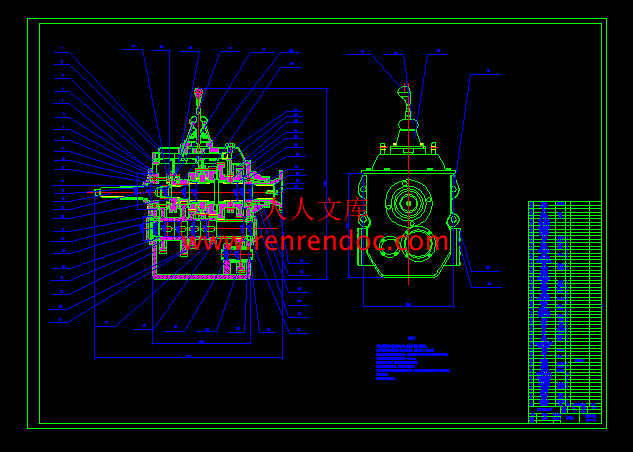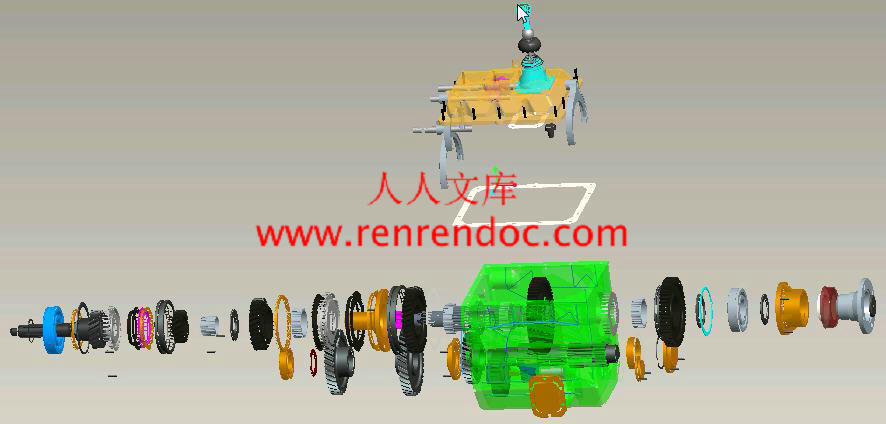汽车变速箱三维设计与仿真
62页 20000字数+说明书+外文翻译+1张CAD图纸+proe三维图
proe三维图.rar
动画仿真.rar
外文翻译--三段式圆弧凸轮分析设计 中文版.doc
外文翻译--三段式圆弧凸轮分析设计 英文版.pdf
汽车变速箱三维设计与仿真开题报告.doc
汽车变速箱三维设计与仿真说明书.doc
装配图.dwg
【摘要】
变速器用来改变发动机传到驱动轮上的转矩和转速,目的是在原地起步,爬坡,转弯,加速等各种行驶工况下,使汽车获得不同的牵引力和速度,同时使发动机在最有利工况范围内工作。变速器设有空挡和倒挡。需要时变速器还有动力输出功能。
因为变速箱在低档工作时作用有较大的力,所以一般变速箱的低档都布置靠近轴的后支承处,然后按照从低档到高档顺序布置各档位齿轮。这样做既能使轴有足够大的刚性,又能保证装配容易。变速箱整体结构刚性与轴和壳体的结构有关系。一般通过控制轴的长度即控制档数,来保证变速箱有足够的刚性。
本文设计研究了三轴式五挡手动变速器,对变速器的工作原理做了阐述,变速器的各挡齿轮和轴做了详细的设计计算,并进行了强度校核,对一些标准件进行了选型。变速器的传动方案设计。简单讲述了变速器中各部件材料的选择。
【关键词】挡数;传动比;齿数;轴
【Abstract】
Transmission to change the engine reached on the driving wheel torque and speed, is aimed at marking start, climbing, turning, accelerate various driving conditions, the car was different traction and speed Meanwhile engine in the most favorable working conditions within the scope of the work. And the trans mission in neutral gear with reverse gear. Transmission also need power output function.
Gearbox because of the low-grade work at a larger role, In general, the low-grade gearbox layout are close to the axis after support, Following from low-grade to high-grade order of the layout of stalls gear. This will not only allow axis are large enough for a rigid, but also ensures easy assembly. Gear box overall structure and rigid axle and the shell structure of relations. Generally through the control shaft length control over several stalls to ensure that adequate gear box rigid.
This paper describes the design of three-axis five block manual trans mission, the transmission principle of work elaborated, Transmission of the gear shaft and do a detailed design, and the intensity of a school. For some standard parts for the selection. Transmission Trans mission program design. A brief description of the trans mission of all components of the material choice.
[Keywords]: block; Transmission ratio; Teeth; Axis
目 录
引言1
1 总体方案设计3
1.1 汽车参数的选择3
1.2变速器设计应满足的基本要求3
2 变速器传动机构布置方案4
2.1 传动机构布置方案分析4
2.1.1 固定轴式变速器4
2.1.2 倒挡布置方案6
2.1.3 其他问题7
3 零部件结构方案分析9
3.1 齿轮形式9
3.2 换挡机构形式9
3.3 变速器轴承11
4变速器设计和计算12
4.1 挡数12
4.2 传动比范围12
4.3 中心距A12
4.4 外形尺寸13
4.5 轴的直径13
4.6 齿轮参数13
4.6.1 模数的选取13
4.6.2 压力角14
4.6.3 螺旋角14
4.6.4 齿宽b16
4.6.5 变位系数的选择原则16
4.7 各挡齿轮齿数的分配17
4.7.1 确定一挡齿轮的齿数17
4.7.2 对中心距进行修正18
4.7.3 确定常啮合传动齿轮副的齿数18
4.7.4 确定其他各挡的齿数19
4.7.5 确定倒挡齿轮齿数20
5 变速器的校核21
5.1 齿轮的损坏形式21
5.2 齿轮强度计算21
5.2.1 齿轮弯曲强度计算21
5.2.2 轮齿接触应力计算22
6 同步器的选型24
6.1 锁销式同步器24
6.1.1 锁销式同步器结构24
6.1.2 锁销式同步器工作原理25
6.2 锁环式同步器26
6.2.1 锁环式同步器结构26
6.2.2 锁环式同步器工作原理26
6.2.3 锁环式同步器主要尺寸的确定27
7 变速器操纵机构30
7.1 直接操纵手动换挡变速器30
7.2 远距离操纵手动换挡变速器31
8 三维建模32
8.1各档位齿轮的建模32
8.2箱体和箱体上盖的建模见下图9.11和9.1237
8.3汽车变速箱整体模型和爆炸图见下图9.13和9.1438
9 变速箱的仿真40
9.1 方针的的第一步,完成三维变速箱的装配40
9.1.1新建装配环境40
9.1.2装配倒档轴组件40
9.1.3装配中间轴组件41
9.1.4装配一二轴组件41
9.1.5完成变速箱的全部装配42
9.2进行仿真42
9.2.1定义齿轮副43
9.2.2定义伺服电动机43
9.2.3机构分析43
9.3保存仿真动画43
10 结论44
致谢45
参考文献46
附录47
现在汽车变速器的发展趋势是向着可调自动变速箱或无级变速器方向发展。无级变速机构由两组锥形轮组成,包括一对主动锥形轮(锥形轮组1)和一对被动锥形轮(锥形轮组2) 同时有一根链条运行在两对锥形轮V形沟槽中间,链条的运动如同动力传递单元。锥形轮组1由发动机的辅助减速机构驱动,发动机的动力通过链条传递给锥形轮组2直至终端驱动。在每组锥形轮中有一个锥形轮可以在轴向移动,调整链条在锥形轮的工作直径并传递速比。两组锥形轮必须保持相同的调整,以保证链条始终处与涨紧状态,使传递扭矩时锥形轮接触充分的压力。采用无级变速器可以节约燃料,使汽车单位油耗的行驶里程提高30%。通过选择最佳传动比,获得最有利的功率输出,它的传动比比传统的变速器轻,结构更简单而紧凑。世界各大汽车制造商正竞相开发无级变速器。专家预计2003至2005年间无级变速器将成为世界各大汽车制造商的技术开发重点。目前一些著名汽车制造商(如福特、通用、本田、克莱斯勒等)正致力于无级变速器的开发工作。现在全球CVT的产量约为50万台,而普通型自动变速器的产量约为2,500万台,双向通讯和线控技术的应用,无级变速器有无比的优势,预计不久将来中国各大汽车制造商也将生产自己的CVT无级变速器,并广泛应用于国产轿车。
在此次设计中对变速器作了总体设计,对变速器的传动方案进行了选择,变速器的齿轮和轴做了详细的设计计算,对同步器和一些标准件做了选型设计。
1 总体方案设计
1.1 汽车参数的选择
根据变速器设计所选择的汽车基本参数如下表
表1.1 设计基本参数
Tablet 1-1 able basic design parameters
项目参数值
发动机:5.5L V12
挡数:5
最大功率(kW/n):380/5000
最大扭矩(N·m/n):830/1900_3500
1.2变速器设计应满足的基本要求
对变速器如下基本要求.
1)保证汽车有必要的动力性和经济性。
2)设置空挡,用来切断发动机动力向驱动轮的传输。
3)设置倒档,使汽车能倒退行驶。
4)设置动力输出装置,需要时能进行功率输出。
5)换挡迅速,省力,方便。
6)工作可靠。汽车行驶过程中,变速器不得有跳挡,乱挡以及换挡冲击等现象发生。
7)变速器应当有高的工作效率。
除此以外,变速器还应当满足轮廓尺寸和质量小,制造成本低,维修方便等要求。满足汽车有必要的动力性和经济性指标,这与变速器的档数,传动比范围和各挡传动比有关。汽车工作的道路条件越复杂,比功率越小,变速器的传动比范围越大。



 川公网安备: 51019002004831号
川公网安备: 51019002004831号